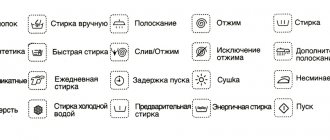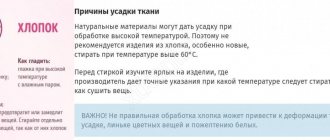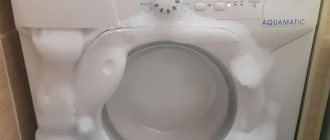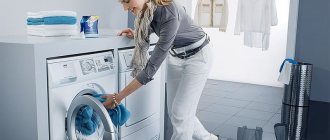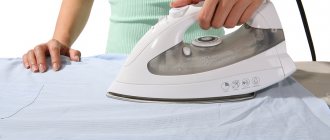A modern washing machine can make life much easier for the housewife. Its versatility allows you to wash materials of various sizes and compositions. The most important thing is to choose the right washing mode. Large items such as blankets and bedspreads require more detailed preparation, and some items are even created exclusively for hand washing. When asking how to wash a blanket in an automatic machine, you should follow some rules. Compliance with them will allow you to obtain a clean product without compromising its quality.
Is it possible to wash a blanket in a washing machine?
To answer whether it is possible or not, you need to consider several factors. The choice of cleaning method depends on the blanket itself and the characteristics of the washing machine.
Bedspreads are made from natural fabrics and synthetics. Each fabric has its own care recommendations. There are three options:
- handwash;
- machine washable;
- dry cleaning
The answer to the first question is yes, you can. Here the second one arises: how to wash a blanket in a washing machine so that it does not spoil?
Each “washing machine” is designed for a certain weight. If the product is too large, it may not be able to pull. Important detail: some fabrics absorb a lot of water and become heavier when wet. You need to focus not on the initial weight, but on the acquired weight. Attempting to force the machine to work under overload can lead to unpleasant consequences, including breakdown.
Create perfect cleanliness in your home
We use bedspreads every day.
They are warm, cozy and comfortable, but only if you care for them properly. Blankets and blankets placed on a bed in a bedroom or sofa, or with constant use, begin to accumulate dust and become hazardous to health. Harmful microorganisms and irritants that can cause allergies spread in the fibers of the material. Proper care of bedspreads is based on the material from which they are made. By the way, with proper preparation, many products can be washed in an automatic machine; the main thing is to know at what temperature to wash the bedspreads. But to do this, you need to understand the characteristics of the fabric before you start washing.
Selecting a mode for washing a blanket
A modern automatic washing machine can operate in 12–14 modes. Unnecessarily, they usually use only half of the functions.
Cotton/linen
One of the “hottest” and most intense. Washing occurs at a temperature of 90º at a speed of 1000 rpm. Suitable for children's clothes or when seriously soiled. At such a high temperature, things practically boil and sterilize.
Kids clothes
Similar to the previous one in temperature and intensity. To this is added a thorough rinsing. This mode is guaranteed to remove stains, get rid of dust mites and remove residues of washing powder.
Read, it’s useful to know: - How to knit baby blankets with your own hands - patterns and diagrams.
Synthetics
The washing temperature in the mode is much lower - no more than 40º. You can increase it by hand, but not all synthetic fabrics can be washed in hot water. Otherwise called “Mixed Fabrics”, this mode allows you to wash several different fabrics at the same time.
Wool
The more natural the fabric, the more delicate the effect becomes. Therefore, the washing mode for wool does not require either too high a temperature (40º) or high speed (800 rpm). Suitable not only for pure wool, but also for yarn with a small percentage of wool in the composition.
Delicate
Analogous to the previous mode. Another name for this is “Gentle Wash”. Suitable for natural, especially delicate fabrics that require careful care. This category includes silk blouses, ties, fine linens and shawls. Temperature - low, speed - no more than 400 rpm.
Manual mode
Some manufacturers do not separate delicate and manual modes. It is suitable when you need to wash items that cannot withstand regular machine washing. The effect on the fabric is gentle, the number of revolutions per minute is minimal.
Quick wash
The operating algorithm is the same. The entire cycle only takes about 40 minutes. Water temperature is 30–40º. Suitable for lightly soiled items or underwear.
Daily wash
In this mode, they wash things that have not gotten very dirty. The drum does not fill completely. One of the most economical modes in terms of time and energy consumption. Washing takes about 50 minutes, the water temperature does not exceed 30º.
Intensive wash
It is used when the dirt is so strong that it cannot be washed normally. Suitable only for linen or cotton, contraindicated for delicate fabrics. Water temperature is 90–95º.
Prewash
This mode is turned on when the item is heavily soiled. Essentially, this is a pre-soak before the main wash. Temperature is low.
Soak
Almost no different from the previous mode. Very dirty items are soaked and prepared for the main wash at a temperature of about 30º.
Night wash
Normal washing, but in silence. During the process, no mechanism is activated that creates noise. The wash completion signal does not work.
Modes for economical use of resources
Special modes that consume less electricity and water. Washing takes less time. In some cases - up to half an hour.
Intelligent programs
Some washing machines are called “smart”. They can control the formation of foam, protect against leaks, refresh waterproof fabrics, distribute things evenly in the drum, etc.
So how to wash a blanket in a machine? The mode is selected depending on the fabric. The required information is indicated on the label.
Preparing for washing
The blanket can be either small or voluminous, euro size. And if in the first case, care and washing do not cause any particular problems, then not all housewives can cope with a real giant.
The blanket needs to be washed regularly, once every 1.5-2 months or less, depending on the frequency of use. It happens that you can do without washing, removing dirt using the dry method.
Before washing any blanket at home, it is important not to skip the preparatory stage:
- Study the composition of the fabric on the label. If it is lost, you can find information on the packaging or the factory website. You can wash a blanket without deformation or damage only taking into account the composition of the fabric.
- Shake out dust and crumbs well or beat out the blanket in the fresh air. After these manipulations, it’s a good idea to ventilate it on the loggia or plot. Often it is dust and an unpleasant smell that makes you think about refreshing your favorite blanket. But if it is generally clean and free of stains, shaking it like this will solve the problem.
- Spot stains can be removed without a full wash. A wet blanket soaked in water is very heavy (especially Euro-size), and it will be difficult to wring it out and dry it. Therefore, if you need to get rid of one or two stains, it is not necessary to wash the entire bedspread.
What should the water temperature be when washing the product?
Blankets should not be washed in very hot water. The optimal temperature is from 30 to 40º. The exact numbers for a particular item depend on the fabric and its properties. The more tender it is, the cooler the temperature should be.
Cotton, polyester, micromodal and other synthetics can withstand 40º, but wool and silk are washed only at 30º with great care. If the fabric of the blanket is mixed, it is washed at a low temperature, taking into account the properties of the fibers included in the composition.
Failure to comply with the temperature conditions can lead to deformation and shrinkage of the product. If it is heavily soiled, cold water will not work - stains may remain on the blanket. It is better to choose another removal method.
Keep in mind! Some sources indicate a permissible temperature of 60º, but it is better not to wash in water hotter than 40º.
Material determination and preparation
Before washing, it is recommended to study the composition of the blanket. In most cases this happens:
- bamboo;
- fleece;
- wool;
- microfiber and other synthetic fabrics.
On the attached label you can read: in what mode the blanket is washed, what temperature to set, spin cycle, etc. The machine must have a load of at least four kilograms. Thin bedspreads can simply be crumpled or folded in half, but bulky items should be distributed over a drum or rolled up. Choose a detergent based on the type of material or manufacturer’s recommendations.
Advice! It is better to purchase gel, as it dissolves quickly, forms less foam and washes out well.
How to machine wash: a guide
In order to wash a blanket in a washing machine, you need to follow the standard algorithm of actions:
- Check the blanket for damage and stains. Remove damage and treat stains with a special product.
- Place in drum.
- Select the desired program at a temperature not exceeding the recommended numbers.
- If possible, select the minimum number of revolutions.
- Use double rinse.
- Do not use the spin function.
- Do not use the drying function.
Important! It is better to wash the blanket separately, without powder, using a liquid detergent.
Basic cleaning methods
If you need to clean a blanket at home, you can resort to two methods: hand or machine washing. But you can also trust the professionals and have the bedspread dry cleaned.
Manually
Certain types of materials may only be cleaned by hand. When washing by hand, you should choose a deep container (for example, a bathtub), since rinsing the blanket in a small basin will not work. Then you need to take warm water and dilute washing powder or carpet cleaner in it. Next, the blanket is soaked for two hours.
Afterwards it is thoroughly washed and rinsed until the foam is completely eliminated. The bedspread is first left to drain in the bathroom and then dried on the balcony. This process is extremely labor-intensive. This is especially true for heavy blankets, which become even heavier from water and are almost impossible to clean.
See also
How to properly wash boxing gloves and bandages in a machine and by hand
In the typewriter
Washing a blanket using an automatic washing machine is much easier. But before washing, you need to make sure that the material from which the blanket is made can be washed in this way. To do this, you need to read the instructions on the label.
Mode selection
The machine must be set to the “Delicate Wash”, “Wool” or “Synthetics” mode for synthetic fabrics.
Temperature
The temperature regime is different for each material. As a rule, the mark should not exceed 30-40 degrees. The most delicate products are fur, cashmere, terry and wool - they are washed exclusively at 30 degrees.
How to choose a product
For washing a blanket, a regular, easily soluble powder is suitable, but for a woolen product, a liquid gel is better. It is also necessary to add conditioner to a separate compartment, which will give the blanket softness. Old stains should first be treated with a special stain remover.
Spin
When washing blankets, it is recommended to set the spin speed to the minimum value. The safest spin for the product and washing machine is 400-500 rpm.
Using dry cleaning
Some materials cannot be washed or dry cleaned. In this case, the blanket must be taken to dry cleaning or laundry. Some fabrics do not tolerate contact with cleaning agents and liquids well.
The dry cleaner will provide safe cleaning that cannot be achieved at home.
Features of washing different bedspreads
Fleece
Fleece is synthetic, so the product requires careful handling. Wash fleece blankets in water at a temperature not exceeding 40º with a liquid product that does not contain chlorine. Spin cannot be used. As a last resort - minimal.
Plush
Plush is a popular upholstery material for furniture and toys. Plush blankets can be washed either by hand or in the washing machine on a delicate cycle. Water temperature - no more than 30º, number of revolutions - no more than 400.
Woolen
Wool is a material that requires special attention. It is capable of absorbing large amounts of moisture. Therefore, the weight of a wool blanket increases significantly during washing. It is worth paying attention to the capabilities of the washing machine in advance. A machine with a load of less than 4.5 kg is not suitable for a wool blanket.
Wool does not tolerate high temperatures, so it is better to wash items made from it at a temperature of about 30º. Spinning is not recommended.
Plaid "grass"
This variety is particularly soft. They are two-layer. The first layer is soft microfiber, and the second is fluffy. One of the features is the pile, the length of which reaches 3 cm.
For some models of this type, machine washing is not recommended. If possible, it is done in a delicate mode, at a temperature of no more than 30º with a chlorine-free product. Spinning is not recommended.
Important! Before washing, items with long pile are either shaken out or cleaned with a vacuum cleaner.
Principles of cleaning
Before sending a blanket or blanket for washing, carefully inspect the product. It is recommended to immediately remove major contaminants:
- A sticky roller will help get rid of cat hair and the hair of other animals;
- A solvent will help remove nail polish that accidentally gets on the bedspread, but first test its effect on an inconspicuous area of the material. You won't be able to remove the varnish with detergents. If the fabric cannot withstand the solvent, take the item to the dry cleaner.
- Before machine washing, remove food stains with a stain remover or hand wash the affected areas. If the stain is definitely not of protein origin, hot steam will help get rid of it.
If you don’t know how to clean a blanket or bedspread and are afraid of ruining it, you should turn to dry cleaning services. A voluminous blanket or large bedspread that does not fit into a home washing machine can be taken to the laundry room, where there are automatic machines with capacious drums.
How to dry a blanket after washing
It is not recommended to dry blankets vertically, especially while water is draining. They are dried in a horizontal position outdoors in dry weather, without contact with direct sun. This is done to avoid product deformation. This applies to both natural fabrics and synthetics. For example, fleece wrinkles easily, so when drying on a line, a crease may appear at the fold.
It is better to keep the drying blanket away from radiators and heaters and let it dry on its own.
Care Tips:
- A baby blanket gets dirty a lot and needs to be washed often with a special detergent to protect the fabric fibers from excessive damage.
- If you have pets in the house, clean the cover with a brush before washing. If the animal sheds or has long hair, you can vacuum it, but you can use a roller with adhesive tape. This method is suitable for removing long hair.
- Treat stains that the machine will not remove, such as wine, grease or blood. You need to use additional products, namely laundry soap or chlorine-free bleach. Never bleach cashmere or wool items, as the fabric may lose color.
- Place the blanket in the machine, it should be alone. There is a little secret: for capes with fur, you can add tennis balls to the blanket to knock the dirt out of the item.
- Dry the blanket in a horizontal position. A wet blanket is very heavy and can become deformed under its own weight. When the fabric becomes damp, hang it in the fresh air, preferably outside, but a balcony is also suitable. Sometimes the bedspread takes a long time to dry and it develops a musty smell.
- If the blanket is made from natural materials, it is better to iron it, since such things can harbor mites and ironing will give the blanket a neat appearance.
How to keep it soft
| Means | Process description |
| Vinegar | For machine washing you will need to pour 2 tbsp. spoons of acid into the conditioner compartment. For washing in a basin - 1 tbsp. l. |
| Soda | Dip the washed blanket in a soda solution (4 tablespoons/10 liters of water). When machine washing, pour baking soda into the rinse aid compartment. |
| Salt | Prepare 2 tbsp saline solution. spoons/5 liters of water. Immerse the product there for 10 minutes, then rinse. |
| Ammonia | Soak the blanket in an ammonia solution (1 tsp per 5 liters of water). |
| Air conditioner | The rinse aid removes static electricity and makes the fibers soft. Add according to instructions. |
Material matters
It is better to wash a faux fur blanket with a liquid detergent and with minimal spin.
- Before the procedure, be sure to shake out and get rid of debris (crumbs, animal hair);
- Make sure that the drum can withstand the weight load, otherwise the unit may be damaged.
- Pour liquid powder and rinse aid into the special compartment;
- Set the “synthetic” mode.
The “synthetic” washing mode is perfect for faux fur blankets - Choose the lowest spin possible.
Blankets made from faux fur are best washed in a machine with the spin function turned off.
Upon completion of the process, the terry product must be hung outdoors, ideally in a draft, why? Yes, because if it dries indoors, it will develop a smell, an unpleasant odor of dampness and staleness. Washing a terry blanket by hand will be very difficult, and the water will drain from it for a very long time, which is guaranteed to create an unpleasant smell. But if there is no other way out, then follow the rules outlined below.
- Add enough liquid to the bathtub to completely submerge the blanket.
- The temperature should not exceed 35C.
- Add liquid powder for delicate washing.
- Distribute the product evenly throughout the bath.
- Immerse and wait 10-20 minutes.
- Without using force, wash with smooth movements.
- Rinse several times and let it drain naturally.
- Dry the blanket, following the recommendations for a machine.
We suggest you familiarize yourself with Clogged Kitchen Sink
Careful care will certainly preserve the delicate fabric and fill the blanket with softness and freshness. Remember that when washing products made from any material, you should not use bleaches or powders containing them. Do not apply detergents to individual areas or scrub them aggressively. This will ruin the structure and color.
Today, blankets are not just “things for the chair.” They can be used as a blanket - cover a bed or sofa with it, take it on a picnic, or cover yourself instead of a blanket. Very large knitted blankets are used instead of floor carpets.
Today, a blanket is a symbol of home comfort.
A good product should be pleasant to the touch, so “soft” materials are used to make blankets. They can be divided according to the naturalness of their composition.
Fleece blankets, despite their “unnaturalness,” are one of the most popular. Fleece is lightweight, compact, soft to the touch, durable and hypoallergenic. It is safe to cover even small children with this blanket. In addition, fleece products are highly wear-resistant and unpretentious. Among the disadvantages, we note high flammability and accumulation of static electricity.
Viscose, unlike fleece, is antistatic and does not electrify. In addition, viscose bedspreads allow air to pass through well and retain heat.
Acrylic also does not electrify and is easy to care for. Acrylic canvas holds paint well, so they are often brighter than others.
Blankets made from fake fur are usually lined with fleece or velor. Faux fur is highly wear-resistant and looks great.
Blankets made from artificial fabrics in the photo
Viscose is one of the most successful fabric options for a blanket. Faux fur looks luxurious, but is more demanding to care for. Fleece blankets are very light, compact, and inexpensive.
Blankets made from synthetic materials can withstand both mechanical and hand washing. It is advisable to prevent the appearance of particularly stubborn stains and heavy old dirt. The water temperature for washing should not exceed 60 degrees, but it is better to be 35–40. It is not necessary to wring it out, but synthetics should be dried naturally, not in the sun and away from heating devices.
https://www.youtube.com/watch?v=OEDxAiwavZc
Cotton blankets can be made from 100% cotton or contain acrylic or wool. They are compact, durable and easy to clean. They are thin and convenient to take on trips or hikes. Delicate fabrics include products made from 100% cotton.
Bamboo fiber for blankets can be processed in two ways - mechanically or chemically (with alkali). “Mechanical” fabric is rougher, but its cost is higher, since it is believed that coarse fibers are environmentally friendly and therefore more beneficial for human health. Chemical treatment gives excellent softness to the threads.
Microfiber is also made from bamboo. To obtain this material, bamboo fibers are artificially split. As a result, the structure becomes more porous, hygroscopicity (absorption) and breathability increase.
Woolen ones are perhaps the most diverse in material. They can be made from sheep wool (Virginia, Merino, New Zealand), goat wool (mohair, cashmere), angora rabbit wool, alpaca wool and camel wool. Products made from wool fabric have all the advantages of products made from natural fabrics, but require special care.
Blankets made of natural fur or silk are the most capricious. They look, of course, expensive and, accordingly, require maintenance. Often the lining for fur is made of silk.
Products made from natural fabrics: photo examples
A cotton blanket, due to its ability to allow air to pass through, is an excellent substitute for a blanket in the warm season. A wool blanket adds comfort to the interior, especially in winter. Alpaca (llama) wool is valuable because of its warming properties. Modern angora blankets are made from the fluff of Angora rabbits. A combination of luxury. and taste - cashmere and silk One of the most expensive materials for a blanket is cashmere. He is extremely fussy about grooming
Products made from natural materials should be washed by hand; even the delicate cycle of a washing machine can damage the fibers. A detergent for such washing also requires a special one, for example, marked “for wool and silk.”
Such products should be dried on a horizontal surface, carefully straightened. You can't hang them, they will stretch.
Blankets made from natural fur should be dry cleaned. This material does not tolerate moisture and requires professional care.
If a couple of stains appear on the blanket, it is better to try to remove them without washing. For example, an iodine stain can be removed by rubbing it with a raw potato cut in half. And in order to remove nail polish marks, use the following advice.
- If the stain is fresh, blot it so that the layer of varnish is as thin as possible.
- Place a soft, clean rag or folded paper towel on the back.
- Soak a cotton pad in nail polish remover or acetone and gently blot the stain until the polish disappears.
- Before starting to remove the stain, do not forget to check the color fastness of the fabric in an inconspicuous place - on a seam, for example.
Chewing gum on your hands can also leave unsightly marks on fabric. To make them disappear, first scrape as much gum as possible from the fabric - this will make it easier to remove it from the fibers. Then wipe the stain with a cotton pad soaked in alcohol. Chewing gum should be washed from the edge of the stain to the center so as not to increase the area of contamination.
After removing such stains, the material will, of course, need to be washed to completely remove any remaining product. But it is better to leave the removal of heavy stains on any type of fabric to professionals.
To determine whether a blanket can be washed in a washing machine, first of all, pay attention to the label with recommendations. It is on it that it is indicated what kind of cleaning the product will withstand without loss. Different types of fabrics have their own cleaning. For example, synthetics are perfectly machine washable.
For optimal washing of a blanket in the SMA, the drum capacity must be at least 4.5 kg. Check if the dry blanket fits in the drum. Large (for example, double) blankets can hardly be washed in a regular machine. If after loading dry, approximately 1/4 of the drum volume remains, feel free to start washing. But don't forget about preparation.
- Shake out the dust. It is better to do this outdoors - on a balcony or in the yard.
- If you have pets, it is better to clean the blanket from wool before washing - the washing result will be better. Wool can be removed with a vacuum cleaner or manually using a soft bristle brush. Wool can be easily removed if you wear regular rubber gloves. If there are very few hairs, you can use a sticky roller or tape.
- Remember that it is better to wash any blankets “alone”, even if there is still free space in the washing machine drum.
These are the most unpretentious materials in washing and general care.
- Place the product in the drum of the washing machine.
- Select a program for delicate fabrics. The water temperature should not exceed 30–40 degrees.
- Recommended spin speed is 800–1000 rpm. Faux fur should not be wrung out; in extreme cases, set the spin mode to 400 rpm.
You can add fabric softener, but not for fleece. Fleece has the property of repelling water and dirt, and conditioning additives can disrupt the structure of the material. And for blankets with long pile, using conditioner will be very useful to soften the piles.
We suggest you read What to do if there is no liquid for lenses. Prepare solution for lenses at home. Using saline solution correctly
Drying. If after washing you decide not to use the spin cycle, then you need to remove excess water.
To do this, lightly wring the fabric without twisting it. Is the blanket too wet? Straighten it with one hand and use the palm of the other to gently drive off excess water. The less the blanket is curled, the smoother it will dry. After washing, a damp blanket made from artificial fabrics can be dried both vertically and horizontally.
You can simply hang the blanket on a rope, but periodically change the fold location to avoid the formation of creases. Or place the blanket on a flat surface, such as a clothes dryer. A faux fur blanket is dried only in such a way that air flows to it in all directions. And don’t forget to periodically change the position of the blanket, otherwise a musty smell will appear.
Do not place wet products near radiators or other heating devices, or in direct sunlight, as this may lead to overdrying and sticking of the fibers. As for ironing, artificial fabrics dry quickly and do not need to be ironed.
What types of blankets are there?
WHAT ARE THERE ARE BLANDS.
- Homemade. They are mini blankets or bedspreads. ...
- Road. Travel blankets are simply indispensable when traveling. ...
- For picnics. Picnic blankets are an indispensable attribute of a comfortable outdoor recreation. ...
- Microfiber. ...
- Flannel. ...
- Acrylic. ...
- Knitted blanket. ...
- Cotton.
Interesting materials:
How much cash can you transport within the European Union? How much cash can you carry through the checkpoint? What is the population of Kyrgyzstan 2022? How much personal income tax for one child? How long do you not eat after cardio? How many weeks are there in this month? How many weeks are there in a school year? How many independent states are there in Australia? How many independent states are there in South America? How long is it normal to stand in a plank?


